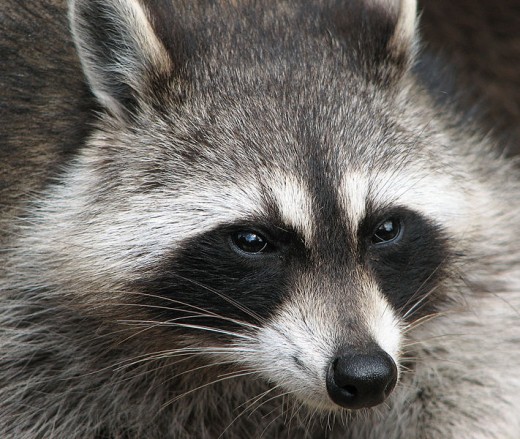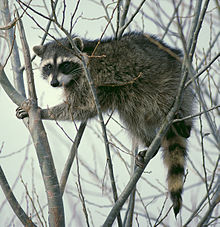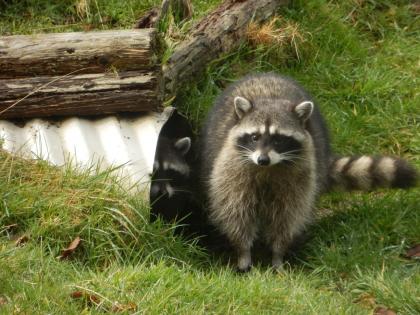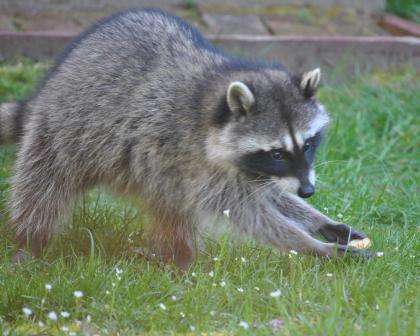How Do You Get Rid of Raccoons? Tips and Tales on Raccoons and Cats
Raccoons Are Smarter Than You Might Think
How smart are raccoons? Extremely smart. Much of my childhood involved a cat-and-mouse-like game between my family and raccoons—they found increasingly clever ways to sneak into our house and steal our cat Pumpkin’s food, and we found increasingly drastic ways to stave them off
Though you might think that humans are savvy enough to have everything under control, raccoons are clever creatures that are surprisingly difficult to thwart. Below I’ll share my personal raccoon experiences with you, as well as share some tips on raccoons and how to get rid of them
Learning From Experience
As I mentioned above, I’ve had enough personal experience with raccoons to know just how difficult it is to get rid of them.
As they might say in some of our local regions, raccoons “are HELLA smart!” Though I live in a fairly urban area, we’ve always had raccoons. Typically, they’ll slink around and poke around trash cans, but at one point during my childhood, the family of raccoons on my block decided that that wasn’t enough. They wanted the good stuff, and the good stuff was inside.
They took to sneaking in through our cat door. We could always tell they had been in our home the morning after a visit (yes, we slept through a lot of these) because they left muddy footprints around the house. That never really got creepy until I woke up one morning to find them around my bed, which is on the second floor on the opposite side of the house. There’s no food there, so that had all of us rather perplexed!

Raccoon
The raccoon is the largest of the procyonid family, having a body length of 40 to 70 cm (16 to 28 in) and a body weight of 5 to 26 kg (11 to 57 lb). Its grayish coat mostly consists of dense underfur which insulates it against cold weather. Three of the raccoon’s most distinctive features are its extremely dexterous front paws, its facial mask, and its ringed tail, which are themes in the mythologies of the indigenous peoples of the Americas. Raccoons are noted for their intelligence, with studies showing that they are able to remember the solution to tasks for at least three years. They are usually nocturnal and omnivorous, eating about 40% invertebrates, 33% plants, and 27% vertebrates.
The original habitats of the raccoon are deciduous and mixed forests, but due to their adaptability they have extended their range to mountainous areas, coastal marshes, and urban areas, where some homeowners consider them to be pests. As a result of escapes and deliberate introductions in the mid-20th century, raccoons are now also distributed across much of mainland Europe, Caucasus, and Japan.
Though previously thought to be generally solitary, there is now evidence that raccoons engage in sex-specific social behavior. Related females often share a common area, while unrelated males live together in groups of up to four raccoons to maintain their positions against foreign males during the mating season, and other potential invaders. Home range sizes vary anywhere from 3 hectares (7.4 acres) for females in cities to 5,000 hectares (12,000 acres) for males in prairies. After a gestation period of about 65 days, two to five young, known as “kits”, are born in spring. The kits are subsequently raised by their mother until dispersal in late fall. Although captive raccoons have been known to live over 20 years, their life expectancy in the wild is only 1.8 to 3.1 years. In many areas, hunting and vehicular injury are the two most common causes of death.
Etymology
Names for the species include the common raccoon, North American raccoon, and northern raccoon, The word “raccoon” was adopted into English from the native Powhatan term, as used in the Colony. It was recorded on John Smith’s list of Powhatan words as aroughcun, and on that of William Strachey as arathkone. It has also been identified as a reflex of a Proto-Algonquian root ahrah-koon-em, meaning “[the] one who rubs, scrubs and scratches with its hands”. The word is sometimes spelled as racoon

Things you think you know about raccoons
They are regularly spotted nearly everywhere in the state. However, a great deal of myth and misconception has grown around the species.
Do raccoons wash their food before eating?
The short answer is no. The longer, and more interesting, answer is raccoons spend a lot of time around water, where they search for food by probing the nooks and crannies among the pebbles and debris on the stream, river or lake. When they find something that might be food, they roll it around in their front paws to determine exactly what it is.
The front paws of a raccoon are extremely sensitive and they use that sensitivity to identify potential food items. If a raccoon encounters a likely item at a distance from water, they will roll it around in their paws right there, without involving any water. It also will often rub its paws together when holding nothing. However, researchers have determined that wetting the paws increases their sensitivity
Where can I get a pet raccoon?
you can’t. The raccoon is among the species that you may not “import, possess, sell, offer for sale or release” under state law
Are raccoons major carriers of rabies?
Raccoons are the No. 1 species documented with rabies in Pennsylvania, with a couple hundred cases or more each year. Skunks are No. 2, usually with less than a hundred per year. Foxes and bats are Nos. 3 and 4, each with a few dozen cases in an average year.

Raccoons
Raccoons are a common sight in much of Washington, often drawn to urban areas by food supplied by humans. As long as raccoons are kept out of human homes, not cornered, and not treated as pets, they are not dangerous
Physical description
The raccoon is a native mammal, measuring about 3 feet long, including its 12-inch, bushy, ringed tail. Because their hind legs are longer than the front legs, raccoons have a hunched appearance when they walk or run. Each of their front feet has five dexterous toes, allowing raccoons to grasp and manipulate food and other items.
Adult raccoons weigh 15 to 40 pounds, their weight being a result of genetics, age, available food, and habitat location. Males have weighed in at over 60 pounds. A raccoon in the wild will probably weigh less than the urbanized raccoon that has learned to live on handouts, pet food, and garbage-can leftovers.
Geographic range
Raccoons prefer forest areas near a stream or water source, but have adapted to various environments throughout Washington. Raccoon populations can get quite large in urban areas, owing to hunting and trapping restrictions, few predators, and human-supplied food.
Food and feeding habitats
Raccoons will eat almost anything, but are particularly fond of creatures found in water—clams, crayfish, frogs, fish, and snails. Raccoons also eat insects, slugs, dead animals, birds and bird eggs, as well as fruits, vegetables, nuts, and seeds. Around humans, raccoons often eat garbage and pet food. Although not great hunters, raccoons can catch young gophers, squirrels, mice, and rats. Except during the breeding season and for females with young, raccoons are solitary. Individuals will eat together if a large amount of food is available in an area

Natural Ways To Get Rid Of Raccoon
Management of Problem Raccoons: Because of their ability to coexist with humans, raccoons can become a nuisance when they damage gardens, raid garbage cans, or inhabit human structures. They can be especially destructive on farms, where they feed heavily on crops and sometimes kill poultry by raiding chicken coops. Many raccoon problems can be controlled using preventive measures. For example, to deter raccoons from raiding garbage cans, several modifications can be made. Snaps can be attached to the lid and the handle can be secured to a stake driven into the ground to prevent opening and tip-over. Placing cans in wooden bins or in the garage may also eliminate raccoon raiding problems. Some people have had success with placing ammonia directly in the can to repel raccoons.
Pet or livestock food should not be left outside where it is available to raccoons. Bird feeders should be placed away from trees or other structures that can be climbed by raccoons. Predator guards can be purchased or made and installed on the feeder poles to prevent climbing.
Raccoons can easily access roofs by climbing trees, downspouts, vines, or a trellis located near the house. Therefore, to prevent raccoons from entering houses, roofs and chimneys should be well-maintained. Repair any holes near the eaves of the roof and securely place a chimney cap over the chimney. Limiting the access to the roof by trimming trees and shrubs may also be helpful.
Raccoons that have already gained access into attics, flues, or storage buildings are often females seeking safe den sites to whelp and raise their young during their lengthy breeding season that runs from late March-May (whelping) into June-July (weaning and pup rearing). Some denning females with young may be able to be tolerated until the young are old enough to leave the den at around 8 weeks of age. When raccoons cannot be tolerated, evicting raccoons by harassment or use of repellents, such as vinegar or ammonia, combined with light and noise from a portable radio, can be effective. After confirming that the raccoons have departed, cap the chimney or repair openings to prevent recurring problems.
Cage trapping of raccoons occupying buildings, damaging gardens and fruit trees, or causing a disease or safety threat may be successfully done by homeowners, BUT it requires considerable knowledge of state trapping laws and legal options for handling trapped raccoons. Connecticut trapping laws require all persons setting traps to check those traps once per day and tag all traps with their name. Properly-set, raccoon-sized cage traps (10” x 12” x 32”) must be set as close to an opening or damage site as possible. The most effective baits include fishy or fruity smelling items, sunflower seeds, and marshmallows. Trapped raccoons, including females with young, may be released on-site, following capping of chimneys and closing openings. The young should be carefully removed from the nest following the female’s capture, making sure that you use bite proof gloves or a capture pole. Place the young in a warm, secure cardboard box near the den opening. Females released on-site will generally return that night for her young.